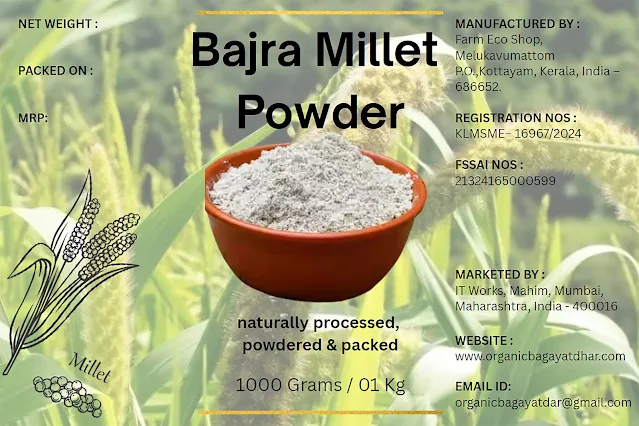 |
| KERALA BAJRA MILLET POWDER |
Processing of Bajra Millet Powder in Kerala
The processing of Bajra (pearl millet) into powder in Kerala, as in other regions, involves several key steps. These steps aim to clean, prepare, and mill the grain into a usable flour form. While specific details might vary slightly based on the scale of production (small-scale home processing versus large-scale industrial processing), the fundamental processes remain consistent.
Pearl millet is a gluten-free cereal crop with significant potential for ensuring food security in many developing countries, and it is a unique source of pro-vitamin A and minerals like calcium, magnesium, and phosphorus.
The primary processing technology of pearl millet is milling, although a number of other processing methods exist.
Here's a breakdown of the typical processing steps:
Cleaning and Preparation
- Harvesting and Initial Cleaning: The process begins with harvesting the bajra grains. After harvesting, the grains undergo initial cleaning to remove any foreign materials like dust, stones, stalks, and other impurities. This can be done manually by hand-picking or using mechanical methods like sieving or winnowing.
- Washing (Optional): Some processors may choose to wash the grains to remove any remaining dirt or debris. This step is not always necessary, but it can improve the final product's quality.
- Drying: After washing (if applicable), the grains need to be thoroughly dried. This can be done by sun-drying or using mechanical dryers. Proper drying is crucial to prevent spoilage and ensure the flour's shelf life.
Preprocessing (Optional)
The content provided mentions several preprocessing techniques that can be applied to pearl millet to improve its properties. These include:
- Blanching: This involves briefly immersing the grains in hot water.
- Debranning: This process removes the outer bran layer of the grain.
- Fermentation: Soaking the grains in water for a period of time.
- Malting: Sprouting the grains.
The content suggests that the combination of fermentation and malting would give the best pearl millet flour with improved technological properties for application in the industries.
Milling
- Milling: The dried and prepared bajra grains are then milled into flour. This can be done using various types of mills, including:
- Traditional Stone Mills: These are often used in small-scale or home-based processing.
- Hammer Mills: These mills use rapidly rotating hammers to crush the grains.
- Roller Mills: These mills use rollers to gradually crush the grains into flour.
- Sieving (Optional): After milling, the flour may be sieved to remove any remaining coarse particles and achieve a finer texture.
Post-Processing and Packaging
- Quality Control: The flour undergoes quality checks to ensure it meets the required standards for fineness, moisture content, and purity.
- Packaging: The bajra flour is then packaged in appropriate containers or bags. The packaging should protect the flour from moisture, pests, and other contaminants to maintain its quality and shelf life.
Specific Considerations for Kerala
While the general process remains the same, some aspects might be specific to Kerala:
- Availability of Equipment: The availability of milling equipment and other processing machinery might vary depending on the region within Kerala.
- Local Preferences: The desired fineness of the flour might be influenced by local culinary preferences.
- Traditional Methods: Some processors might incorporate traditional methods or techniques specific to Kerala's food culture.
The content also mentions that the primary processing technology of pearl millet is milling, although a number of other processing methods exist.
Therefore, the processing of Bajra millet powder in Kerala involves cleaning, optional preprocessing, milling, and packaging. The specific methods and equipment used may vary depending on the scale of production and local preferences.
| INQUIRY OR ORDER NOW |

